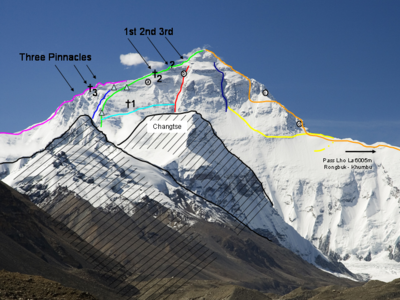Norton Couloir
The Norton Couloir or Great Couloir is a steep gorge high on the north face of Mount Everest in Tibet which lies east of the pyramidal peak and extends to within 150 m below the summit.
Its companion to the west of the summit is the Hornbein Couloir.
| Green line | Normal route, largely corresponds to the 1924 Mallory Route, with high-altitude camps at about 7,700 and 8,300 m, today's 8,300 m camp is somewhat more to the west (2 triangles) |
| Red line | Great Couloir or Norton Couloir |
| Light blue line | 1980 Messner Traverse; in 1924 Norton crossed the north face between the light blue and the green lines |
| b) | Point on west face of the couloir, up to which Edward Felix Norton ascended in 1924 |
Contents
Origin of the name[edit]
The steep gorge was named after the lead member of the 1924 British expedition, Edward Felix Norton, who reached a height of about 8,570 metres (28,120 ft) in this steep valley during an unsuccessful summit attempt on 4 June 1924. He avoided the dangerous windswept ridge and, by traversing the north face, ascended into the gorge which has since borne his name.
Everest solo, Reinhold Messner[edit]
The Norton Couloir was the scene of one of the greatest mountaineering achievements when, in 1980, Reinhold Messner entered this gorge to avoid what, for a solo climber, was a dangerous ridge - especially to circumvent the Three Pinnacles - and ascended to the summit, alone and without using supplemental oxygen. The most successful climb to that point by F. Edward Norton in 1924, was Messner's inspiration for this attempt: Norton had also used no oxygen.
Other climbs through the couloir[edit]
In 1984 an Australia expedition succeeded in climbing a new route. From the main branch of the Rongbuk Glacier they went directly onto the north face and established their third high-altitude camp at the entrance of the couloir at 7,500 metres. From another camp at 8,150 m Tim Macartney-Snape and Greg Mortimer reached the summit on 2 October without bottled oxygen, the first Australians to reach the top of Everest.[1]
In 2001, young French snowboarder Marco Siffredi succeeded in the first snowboard descent of Everest by using the Norton Couloir. He died the following year attempting a new descent via the Hornbein Couloir.[2]
References[edit]
- ^ Bartram, Geoffrey: Everest via the Great Couloir. In: AAJO 1985. S. 338[permanent dead link]
- ^ "Everest Snowboarder Vanishes On Second Try". National Geographic. 27 September 2002. Retrieved 22 August 2011.
Sources[edit]
- Tom Holzel, Audrey Salkeld: In der Todeszone - Das Geheimnis um George Mallory; Goldmann, München 1999, ISBN 3-442-15076-0
- Conrad Anker, David Roberts: Verschollen am Mount Everest - Dem Geheimnis von George Mallory auf der Spur; Heyne, München 1999, ISBN 3-453-17711-8
- Reinhold Messner: Everest Solo; Fischer, Frankfurt 2001 - ISBN 3-596-15092-2


